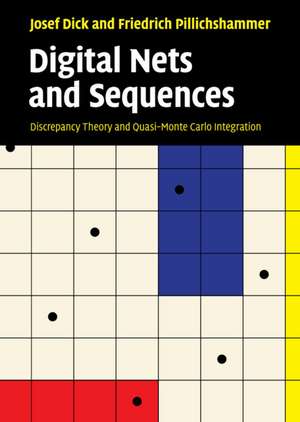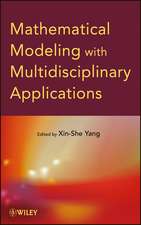Digital Nets and Sequences: Discrepancy Theory and Quasi–Monte Carlo Integration
Autor Josef Dick, Friedrich Pillichshammeren Limba Engleză Hardback – 8 sep 2010
Preț: 709.61 lei
Preț vechi: 797.32 lei
-11% Nou
Puncte Express: 1064
Preț estimativ în valută:
135.78€ • 142.15$ • 112.35£
135.78€ • 142.15$ • 112.35£
Carte tipărită la comandă
Livrare economică 05-19 aprilie
Preluare comenzi: 021 569.72.76
Specificații
ISBN-13: 9780521191593
ISBN-10: 0521191599
Pagini: 618
Ilustrații: 45 b/w illus. 260 exercises
Dimensiuni: 180 x 254 x 35 mm
Greutate: 1.23 kg
Ediția:Nouă
Editura: Cambridge University Press
Colecția Cambridge University Press
Locul publicării:Cambridge, United Kingdom
ISBN-10: 0521191599
Pagini: 618
Ilustrații: 45 b/w illus. 260 exercises
Dimensiuni: 180 x 254 x 35 mm
Greutate: 1.23 kg
Ediția:Nouă
Editura: Cambridge University Press
Colecția Cambridge University Press
Locul publicării:Cambridge, United Kingdom
Cuprins
Preface; Notation; 1. Introduction; 2. Quasi–Monte Carlo integration, discrepancy and reproducing kernel Hilbert spaces; 3. Geometric discrepancy; 4. Nets and sequences; 5. Discrepancy estimates and average type results; 6. Connections to other discrete objects; 7. Duality Theory; 8. Special constructions of digital nets and sequences; 9. Propagation rules for digital nets; 10. Polynomial lattice point sets; 11. Cyclic digital nets and hyperplane nets; 12. Multivariate integration in weighted Sobolev spaces; 13. Randomisation of digital nets; 14. The decay of the Walsh coefficients of smooth functions; 15. Arbitrarily high order of convergence of the worst-case error; 16. Explicit constructions of point sets with best possible order of L2-discrepancy; Appendix A. Walsh functions; Appendix B. Algebraic function fields; References; Index.
Recenzii
"It will give readers the confidence that their estimates of variance are tractable, and they can therefore use quasi-Monte Carlo (QMC) integration to do the software engineering tradeoff analysis that is critical to professional software project management and architecture. This textbook--and believe me, it is a textbook--will lead students to a deep understanding of the potential errors that can be expected."
Larry Bernstein, Computing Reviews
"This book provides a self-contained and comprehensive exposition of one of the most attractive techniques for numerical integration, the so-called quasi-Monte Carlo (QMC) rule. As well-known specialists in the field, the authors have made a tour de force to include, systematize, and unify their achievements and an impressive number of results of other people. By introducing the concepts and methods in an accessible and intuitive form, the authors have provided a useful book that is accompanied by a lot of illustrative examples, graphics and applications."
Petru P. Blaga, Mathematical Reviews
Larry Bernstein, Computing Reviews
"This book provides a self-contained and comprehensive exposition of one of the most attractive techniques for numerical integration, the so-called quasi-Monte Carlo (QMC) rule. As well-known specialists in the field, the authors have made a tour de force to include, systematize, and unify their achievements and an impressive number of results of other people. By introducing the concepts and methods in an accessible and intuitive form, the authors have provided a useful book that is accompanied by a lot of illustrative examples, graphics and applications."
Petru P. Blaga, Mathematical Reviews
Notă biografică
Descriere
An introduction to contemporary quasi–Monte Carlo methods, digital nets and sequences, and discrepancy theory. Includes many exercises, examples and illustrations.








